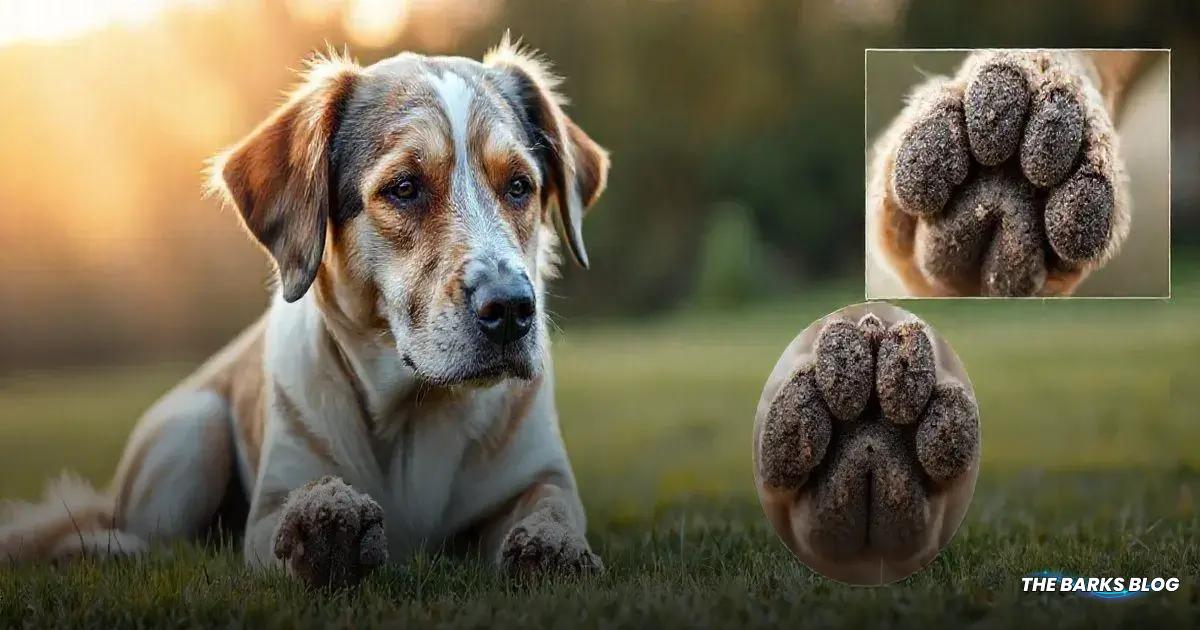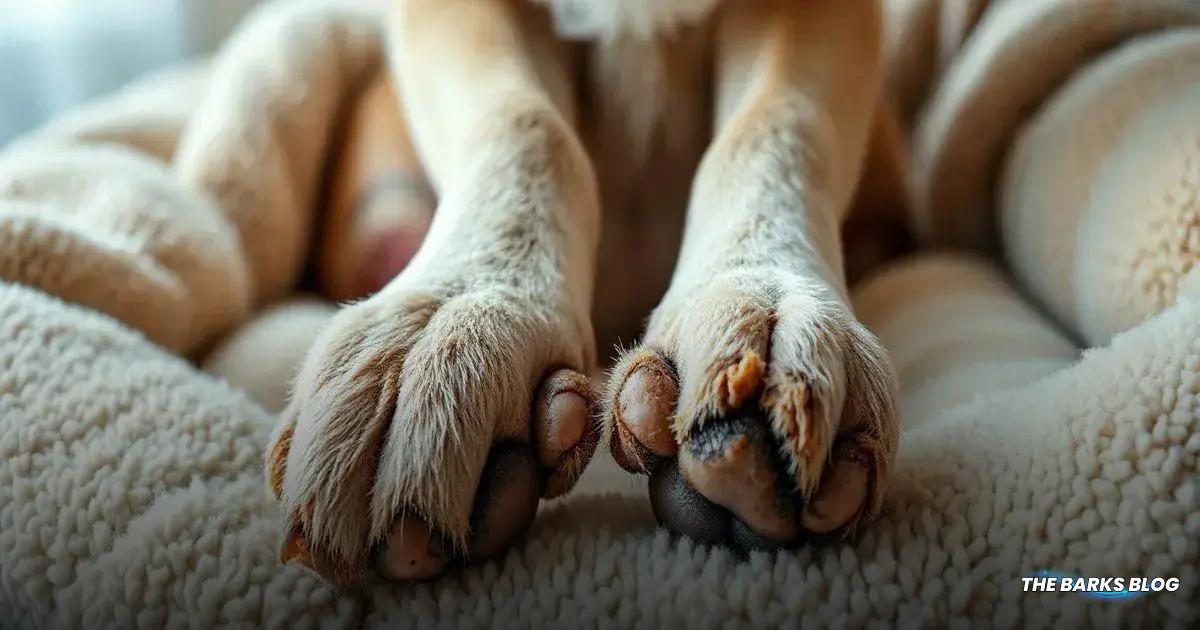Dog paw hyperkeratosis is a condition characterized by the thickening of the skin on a dog’s paw pads, often resulting in a crusty appearance. It can be caused by factors such as aging, genetic issues, infections, or autoimmune diseases. Symptoms include thickened pads and discomfort, with potential for secondary infections if untreated. Management involves addressing underlying causes, maintaining hygiene, trimming excess keratin, and applying dog-safe moisturizers, with regular veterinary check-ups being crucial for your dog’s health.
Dog paw hyperkeratosis is a condition where the paw pads become thickened and crusty, often affecting older dogs. Understanding its symptoms and management is key to ensuring your furry friend stays comfortable.

What is Dog Paw Hyperkeratosis?
Dog paw hyperkeratosis is a condition characterized by the thickening of the outer layer of skin on your dog’s paw pads. This outer layer, known as keratin, serves as a protective barrier, much like a shield for the underlying tissues. In healthy dogs, the keratin layer is usually smooth and flexible, allowing for natural movement and comfort.
However, when this keratin layer becomes excessively thickened, it can lead to various issues. The paws may appear crusty, rough, or even ‘hairy’ due to the formation of fronds. This thickening can occur in response to pressure or friction, similar to how humans develop calluses on their feet. While some dogs may experience this condition without any apparent cause, it is particularly common in older dogs.
In some cases, dog paw hyperkeratosis can be a sign of other underlying health issues, such as autoimmune diseases or infections. Therefore, it’s crucial to monitor your dog’s paw health and consult a veterinarian if you notice significant changes. With proper management, most dogs can live comfortably despite this condition.

Symptoms of Dog Paw Hyperkeratosis
The symptoms of dog paw hyperkeratosis can vary in severity, but there are several common signs to watch for. Owners may notice that the surface of their dog’s paw pads appears thickened and crusty. In some cases, the pads may develop a feathery or ‘haired’ appearance due to the abnormal keratin growth.
As the condition progresses, dogs may experience discomfort, which can manifest as licking or chewing at their paws. This excessive grooming can lead to further irritation and even corns or fissures developing on the pads. If left untreated, these cracks can become painful and may allow for secondary infections to take hold, resulting in inflammation and additional symptoms such as limping or reluctance to walk.
Other symptoms to be aware of include:
- Redness or swelling: Inflammation around the paw pads can indicate irritation or infection.
- Odor: A foul smell may arise if there is an infection present.
- Behavior changes: Dogs may become more withdrawn or exhibit signs of pain when walking or playing.
If you observe any of these symptoms, it’s essential to consult your veterinarian for a proper diagnosis and treatment plan to ensure your dog remains comfortable and healthy.

Causes of Dog Paw Hyperkeratosis
Dog paw hyperkeratosis can be caused by a variety of factors, and understanding these causes is crucial for effective management. Here are some of the primary causes:
Aging
One of the most common causes of paw hyperkeratosis is aging. Many dogs, particularly middle-aged and older ones, may develop this condition without any known reason, referred to as idiopathic hyperkeratosis. This type can often occur alongside similar conditions affecting the nose.
Inherited Disorders
Genetic factors can also play a role. Certain breeds, such as the Dogue de Bordeaux, Golden Retriever, and Labrador Retriever, are predisposed to hyperkeratosis due to inherited genetic disorders. Symptoms in these cases typically appear during the first few years of life.
Infections and Parasites
While less common, infections or parasites can lead to hyperkeratosis. For example, the Canine Distemper Virus can cause severe symptoms, including hyperkeratosis of the paws and nose. Additionally, fungal infections like dermatophytosis may contribute to the condition.
Zinc-Responsive Dermatitis
This uncommon cause affects dogs of any age but is particularly seen in breeds like Huskies and Malamutes. A deficiency in zinc can lead to crusting and scaling of the skin, including the paw pads.
Autoimmune Diseases
Autoimmune conditions, though rare, can also cause hyperkeratosis. The most notable is pemphigus foliaceous, which results in ulceration, crusting, and scaling of the skin, often affecting the paws.
Other Causes
There are also rare causes of hyperkeratosis, including some forms of cancer and conditions like hepatocutaneous syndrome, which can lead to inflammation and ulceration alongside hyperkeratosis.
Identifying the underlying cause of your dog’s hyperkeratosis is essential for determining the appropriate treatment and management strategies. Always consult your veterinarian if you suspect your dog may be affected.

How to Manage Dog Paw Hyperkeratosis
While dog paw hyperkeratosis often cannot be cured, there are several effective management strategies to help keep your dog’s condition under control and improve their quality of life. Here are some recommended approaches:
- Treat Underlying Diseases: If hyperkeratosis is caused by infections, autoimmune diseases, or nutritional deficiencies, addressing these underlying issues can help resolve the symptoms over time. Consult your veterinarian for appropriate treatments.
- Trim Excess Keratin: In severe cases, trimming back the excess keratin can be beneficial. This should ideally be done by a veterinarian, but if you choose to do it at home, ensure you soften the keratin first by soaking the paws in warm water.
- Warm Water Soaks: Regularly soaking your dog’s paws in warm water with Epsom salts for about 10 minutes can help hydrate and soften the paw pads, making them more comfortable.
- Apply Ointment or Balm: Using dog-safe moisturizing products can help keep the paw pads supple and minimize the impact of hyperkeratosis. Look for balms specifically designed for dogs to ensure safety and effectiveness.
- Keep Paws Clean and Dry: Maintaining hygiene is crucial as hyperkeratosis can increase the risk of infections. Make sure to clean your dog’s paws regularly and dry them thoroughly after walks, especially in wet or muddy conditions.
- Consider Boots: For dogs that are uncomfortable walking on hard surfaces, dog boots can provide protection and comfort, helping to alleviate pressure on the paw pads.
- Monitor for Pain or Infection: Keep an eye on your dog for any signs of pain, such as licking, redness, or limping. If you notice these symptoms, contact your veterinarian promptly to prevent complications.
- Use Medication if Needed: If your dog develops an infection as a result of hyperkeratosis, your veterinarian may prescribe antibiotics or antifungal treatments to address the issue.
By implementing these management strategies, you can help your dog live a comfortable and happy life, even with the challenges posed by paw hyperkeratosis. Regular veterinary check-ups are essential to monitor the condition and adjust treatment as necessary.
Conclusion
Managing dog paw hyperkeratosis may seem daunting, but with the right strategies in place, you can help your furry friend lead a comfortable and fulfilling life.
Understanding the symptoms and causes of this condition is essential for effective management. By treating any underlying issues, maintaining proper hygiene, and using appropriate products, you can minimize discomfort and prevent complications.
Remember, while hyperkeratosis may primarily be a cosmetic concern for many dogs, it can lead to pain and secondary infections if left untreated.
Regular veterinary visits and monitoring your dog’s paw health will go a long way in ensuring their well-being. With your care and attention, your dog can continue to enjoy their daily activities and thrive despite this condition.
FAQ – Frequently Asked Questions about Dog Paw Hyperkeratosis
What is dog paw hyperkeratosis?
Dog paw hyperkeratosis is a condition characterized by the thickening of the outer layer of skin on the paw pads, often leading to a crusty or ‘hairy’ appearance.
What causes dog paw hyperkeratosis?
The condition can be caused by several factors, including aging, inherited disorders, infections, autoimmune diseases, and nutritional deficiencies.
How can I manage my dog’s hyperkeratosis?
Management strategies include treating any underlying conditions, trimming excess keratin, soaking the paws, applying moisturizers, keeping the paws clean, and using protective boots.
Are there any specific breeds prone to hyperkeratosis?
Yes, certain breeds such as the Dogue de Bordeaux, Golden Retriever, and Labrador Retriever are predisposed to developing hyperkeratosis due to genetic factors.
Can hyperkeratosis lead to other health issues?
If left untreated, hyperkeratosis can cause pain, discomfort, and secondary infections, which may lead to further health complications.
Should I consult a veterinarian if I notice symptoms?
Yes, it’s important to consult a veterinarian if you notice any signs of hyperkeratosis in your dog to ensure proper diagnosis and management.




